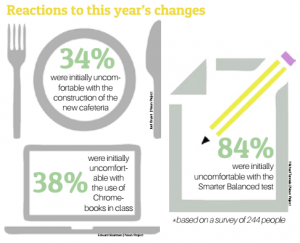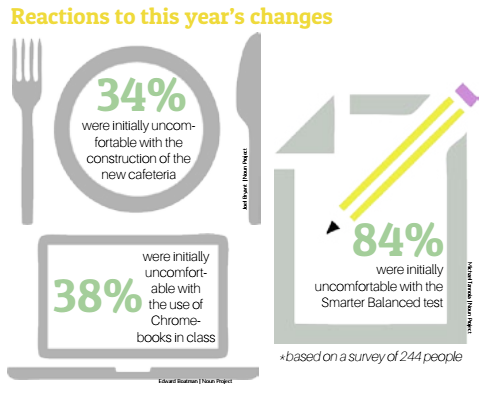4,100. That’s the number of hours we will have spent in high school by the time we graduate. In that time, we would like to think that we have made an impact, that when we leave, we will have left the school different from the way it was when we first arrived. To do so, we, as a school and as a community, should aim to not only recognize the need for change and adaptation, but also have the proper attitude while implementing it.
In this year alone, MVHS has experienced an overwhelming amount of change throughout all aspects of the school. Beginning with the opening of the new cafeteria in April 2014, to the increase in Chromebook use in literature and social studies classes in August 2014 and finally to the continued implementation of Smarter Balanced Testing in April 2015, this year has been eventful, to say the least.
 Some of these changes were met with approval, while others were met with strong opposition, but that’s completely natural with change and should not prevent the school and its students from advocating change. A study conducted by Arizona State University states that any type of change introduced in schools is often met with resistance and is doomed to fail at first due to what is known as school culture, or the set of norms, values and beliefs that make up the persona of the school. The study observed that school administrators often fear making changes, worrying that attempting to alter the school culture will be met with opposition.
Some of these changes were met with approval, while others were met with strong opposition, but that’s completely natural with change and should not prevent the school and its students from advocating change. A study conducted by Arizona State University states that any type of change introduced in schools is often met with resistance and is doomed to fail at first due to what is known as school culture, or the set of norms, values and beliefs that make up the persona of the school. The study observed that school administrators often fear making changes, worrying that attempting to alter the school culture will be met with opposition.
It’s saddening to think that such a fear has the power to get in the way of those looking to make a change when in reality, the possibility of resistance should be the last thing on their minds. To prevent this, it is essential that we are willing to adapt in response to the environment and conditions around us. Just as populations evolve and acquire certain traits by adapting to changing circumstances, we, as a school, should also attempt to redefine ourselves, step out of our comfort zone and be open to the previously unfamiliar. Our biggest fear should be the possibility of remaining constant and unchanging, rather than the possibility of having to make a difficult adjustment.
Douglas Reeves, a nationally acclaimed education author, writes in a study that in order for a change in schools to have a positive impact, those involved need to believe that said change could have a positive effect. Without faith in the potential beneficial effects of change, no attempt will ever find prolonged success. He also explains that school culture is not a static entity — rather, it is constantly being shaped through interactions with others and the surrounding environment, meaning that cultural change is not only favorable, but also necessary for the prosperity and growth of the school as well as the happiness of its students and faculty.
So before complaining about how construction causes heavy traffic or how a change in standardized testing is messing up the schedule, we should first try to to consider the impact of the change with regard to its intended effects. Rather than becoming complacent and assuming that our school is fine the way it is, we need to keep an open mind, thus fostering the right environment for change and allowing the process to occur as smoothly as possible.
An essay written by professors at Princeton University suggests that the purpose of high school is, essentially, to prepare students for the terrifying, and at times nightmare-inducing, “real world.” And in the real world, if anything is guaranteed, it is that nothing ever remains constant. We need to be able to adapt to a changing culture if we are ever to adapt to a changing world.
By recognizing when change is required early on and then reacting to that change in an appropriate manner, we will not only make a significant impact on the school, but also prepare ourselves for what is to come in the future. Change is important, but being willing to adapt and having the right attitude towards change is just as, and perhaps even more, valuable.
We have 4,100 hours. Don’t waste any more.





